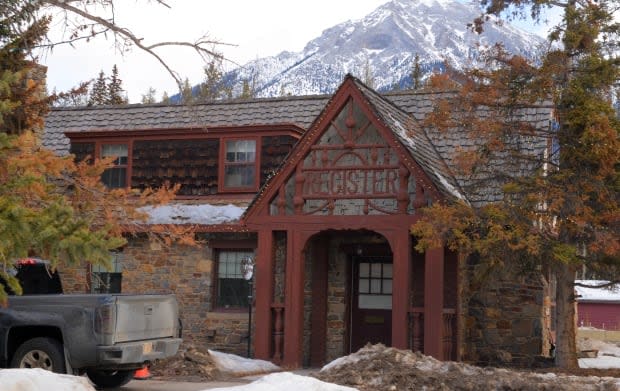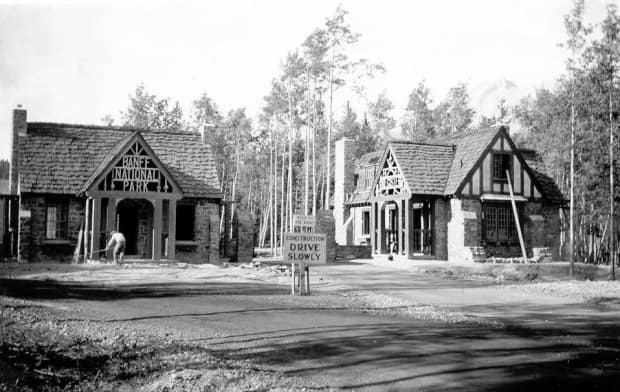Banff East Gate buildings see millions of visitors drive by, but there's a story behind them

Every year, about four million people visit Banff National Park — many driving through the East Gate.
But those buildings aren't just for car traffic. They've served as homes and offices for Parks Canada employees since they were built in the 1930s.
Each building has its function and character.
"I kind of think of it as a portal from ordinary life into a special place," said Steve Malins, the park's cultural resource management advisor. "You knew that you had arrived somewhere when you came to the Banff Gate. It answered that relentless question from the back seat: Are we there yet? Yes, you have arrived."
Times at the national park are changing. Officials are looking forward and trying to decide how to best manage visitors and those arriving in cars. Decisions are being made about what is and isn't sustainable in terms of tourism.
But while policies in the park may change, the three East Gate buildings won't — they're protected as federal heritage buildings.
How we use them might change," said Banff visitor experience manager Daniella Rubeling. "At this time, you know, the hang tag and the system we use for national park entry isn't changing, but that is where the agency is looking. Where does that go in the future and how does digital play a role in that?"

When the gates first opened, the highway they guard wasn't yet twinned. Cars had to register to enter and sign out to leave. Now, a through lane and hang tags make for a quicker entry.
Rubeling says one thing has stayed consistent.
"The welcome — the 'hello bonjour, welcome to Banff National Park' — that hasn't changed, and that is a big part of what makes these gates so special still today," Rubeling said.

Getting to Banff National Park in its early days, when it was still known as Rocky Mountain Park, was a bumpy ride for vehicles on the unpaved Banff Coach Road. Cars were allowed only after 1911, when the federal government lifted a ban that was put in place in 1905.
In the first few years, motorists had to drive to the RCMP detachment to register and pay for the privilege of being in the park boundaries. But in 1916, a gate was established because the police found that with the growing popularity of cars, this task was interrupting other work.
This is when the East Gate first entered the picture, but in a different location: near Exshaw, on what is now Highway 1A.
Gatekeeper Annie Staple started the job in 1916 while her husband worked as a game warden for the park. In the beginning, she set herself up at a table by the side of the road, a tent behind her to keep out of the rain, said historian and writer Rob Alexander.

She didn't have an official uniform. The navy blue number didn't come until nearly a decade later, in 1925. So her roadside operation caught some off guard.
"If you're suddenly stopped by someone on the side of the road and they ask you for money, it's kind of like that. Seems a little dubious," Alexander said. "The second driver that she charged went straight to the police and reported her."
At that time, visitors to the park had to stop at the gate and register their name; vehicle's make, model and colour; and their home address. On the way out, they had to confirm leaving the park by signing out. It cost $1 a day, Alexander said.
Just a year after she started, the second summer, things started taking shape . A wooden post structure went up to truly form a gate, along with a booth for Staple to sit in. Eventually, a house was also built so she could have her family close — even though they lived only a short jog away in Exshaw.

Unfortunately, her husband, Tom Staple, died in 1919 while Annie Staple was pregnant with their fourth child.
"Pretty remarkable that she was doing this, this job. And given its hours and its demands, I'm not quite sure how she managed it," Alexander said.
In 1930, the National Parks Act came into play. It outlined just how the Rocky Mountains Park should be managed, enshrining ecological protection as a keystone. With the act came a revision to the park boundary. The East Gate was moved about 35 kilometres west.
Canmore's coal mines, a cement plant and limestone operations — many familiar landmarks you hit on the Trans-Canada Highway before passing through Canmore to get to Banff — didn't fit in, Alexander said.
"They didn't like the look of the communities because it didn't fit this idea of a tourist destination," Alexander said. "They had a vision of what people wanted to see, and that's not what they saw in Canmore and Exshaw."

There is a photo of Annie Staple standing in front of the new gates, but not much information about her having lived there. A Calgary Herald article published to commemorate Banff's "Guardian of the Gate" at her retirement in 1948 mentioned that she was going to make her home with her daughter in Seebe.
"This stretch of history from 1916 to 1948 … she would have seen the park through that whole fairly tumultuous period," Alexander said. "The kind of the growth of the park and the shrinking and the change in tourism and the nature of tourism, the change in the ideals of protection and sort of what protection-preservation is and should be."
Car boom despite economy bust
Malins said the new gates were built to accommodate cars.
"Even though the depression was going on, you're seeing the evolution across North America of a new type of person: the car owner," Malins said. "Vehicles were becoming much more popular. And in response to that, the gate was established."
Designed by architect Harold C. Beckett, who also dreamt up the Parks Canada Administration Building in Banff, the East Gate structures take on a more cottage-like feel with Tudor revival elements. The exterior features timbered wood, stucco and burled log columns, with Rundle stone.
"The intent for the Lane 1 cottage was for a caretaker's cottage and staff accommodation," Malins said.

Entering the small home, you first move through a kitchen, which has been updated to serve the workers currently on site.
Then, the main hallway leading to the living room is wood-panelled. There is a set of stairs leading up to two bedrooms and an upstairs bathroom. The living room is complete with a fireplace, which is no longer in use but would have heated the cottage when people were living there.
There is a basement, too, which is now used for storage and to do laundry on-site.
"I think out of all the kiosks that we have today, this one, the interiors probably stayed the most original," Malins said.
Nowadays, Rubeling said, there can be 30 to 50 people working away at the East Gate. I's no longer a one-woman operation. People don't live at the gate anymore. The pace has changed from the 1930s, when these gates welcomed 134,000 visitors a year.
"It's tighter, it's quicker," Rubeling said.

